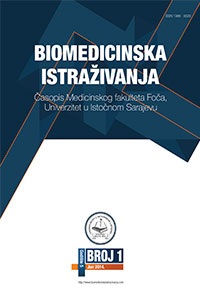Late postoperative complications of arteriovenous fistula for hemodialysis
DOI:
https://doi.org/10.5937/BII2101069MAbstract
The vascular approach is a prerequisite for performing hemodialysis,
but their “weak points” are different and frequent complications. Modern
guidlines recommend native arteriovenous fistula (AVF) as the first
choice of vascular approach, because it is characterized by the longest
survival and the least complications compared to other vascular approaches.
All complications of AVF can be divided into intraoperative,
early, and late postoperative. This paper presents the late postoperative
complications of AVF, their frequency, causes, diagnosis and treatment.
The most important late postoperative complications are: stenosis,
thrombosis, aneurysm or pseudoaneurysm formation, infection, hand
edema, hematoma, ischemic steal syndrome, ischemic neuropathy,
congestive heart failure. Large differences in the frequency of each
complication in earlier studies can be explained by differences in surgical
technique, localization of AVF, diagnostic methods, but, above all,
differences between the presented groups of patients. It is described
that the age of patients, sex, underlying disease, the presence of comorbid
conditions and various metabolic and immune disorders characteristic
of chronic renal failure, as well as the way of using and caring
for AVF significantly affect the occurrence of AVF complications. One
of the main predictors of AVF success and survival is the quality of the
patients’ blood vessels, and therefore careful examination of blood
vessels before approaching AVF creation is of particular importance.
The creation, use and care of AVF is the task of the team of health professionals
who take part in the treatment of these patients, and successful
treatment requires their good cooperation, as well as cooperation
with patients.

